“A Cheap Farm House” (c. 1864—)
by Jessica Mace
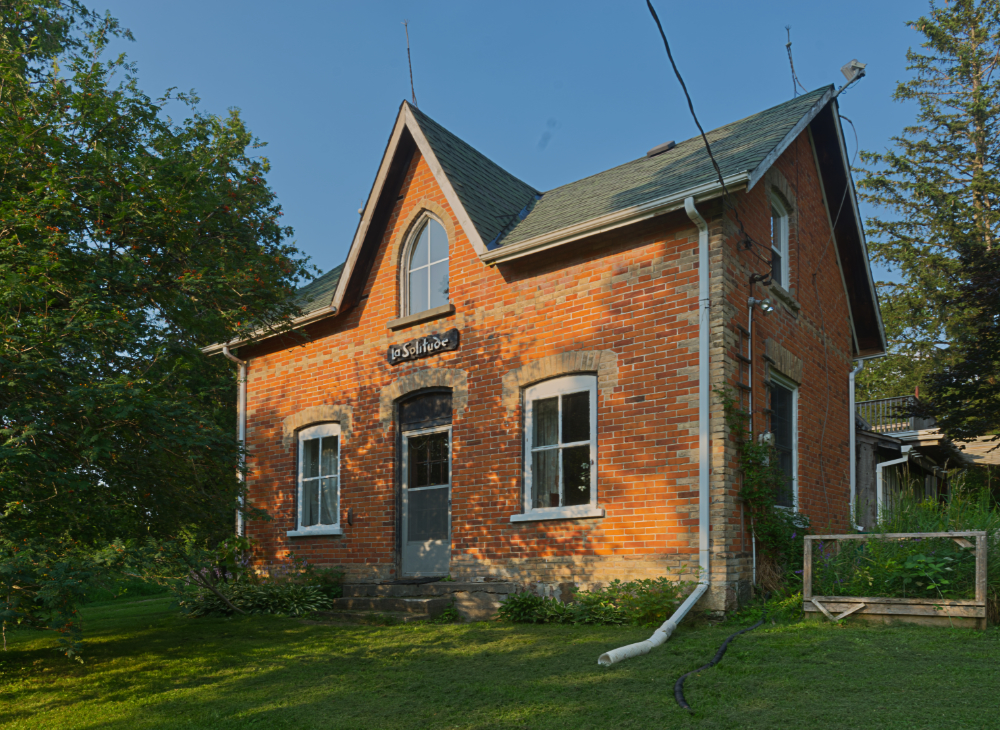
When you walk through any town in Ontario, Canada, or drive down any of its rural roads, if you look closely at the old houses, you’ll notice that many bear a striking resemblance to one another. This is no accident. In the nineteenth century, as settler development expanded across the territory, architectural plans were circulated in print for prospective homeowners. The purpose of the published designs was so that anyone could build a comfortable and attractive home, with local materials, even in remote places that were beyond the reach of trained architects. Although labeled as a farm house, the design for “A Cheap Farm House” became popular in both the country and the city.
The Canada Farmer

The house pictured above stems from a design published in The Canada Farmer in November of 1864 called “A Cheap Farm House.”[1] Founded this same year by George Brown, the owner and publisher of the Globe, the bi-weekly periodical was dedicated to agricultural interests. The publication was founded on the belief that the future prosperity of Canada was closely tied to its agriculture, part of the larger settler-colonial project extended to the construction and appearance of rural homes.[2]
“Architecture is perhaps a complimentary word when used in reference to most of the structures which have been erected upon the farms of Canada,” wrote The Canada Farmer, and for this reason, the periodical intended “to do somewhat toward improving the style of rural architecture in Canada.”[3] The aim of The Canada Farmer’s editors and authors was to spread what they perceived as good taste and architectural ideals to those in rural areas beyond the reach of architects, who mostly lived and worked in big cities. From its very first issue, the journal featured a series on rural architecture that included general advice, but more importantly, architectural drawings, cost estimates, and instructions for construction to help the average person build a house. The “Cheap Farm House” elevation that we see here was attractive but also simple enough to be easily achievable without an architect.
“A Cheap Farm House” model
The designs for the various houses printed in the pages of The Canada Farmer were created by James Avon Smith, a budding Toronto-based architect who would go on to have a prolific career. Although a number of models in different styles were published, “A Cheap Farm House” was one of the most popular. Its simple form was easy to recreate and to modify, even in the absence of an architect. It made use of the most basic form for a building, using simple techniques drawing on the vernacular—that is, local knowhow and traditions—so that any builder could execute this design.
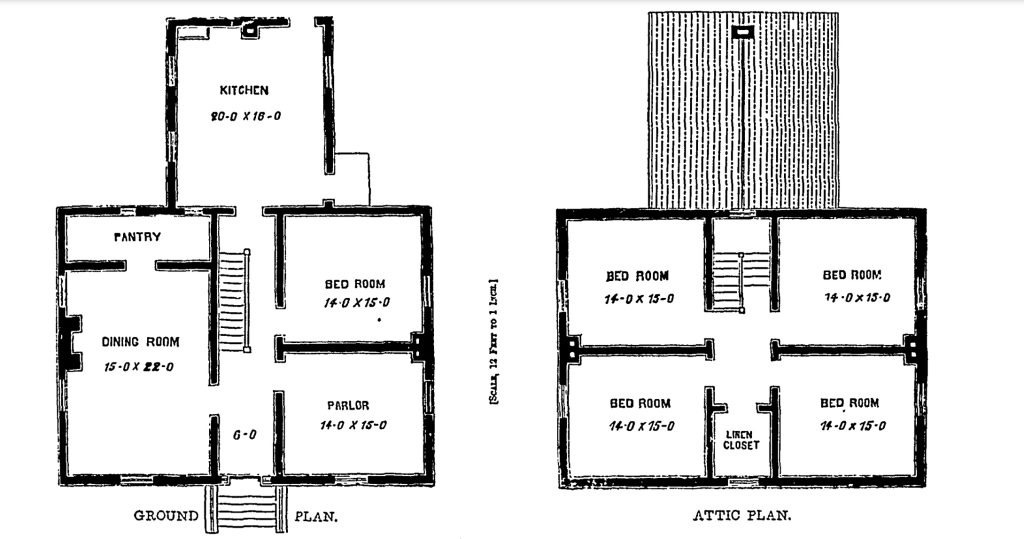
Built on a simple rectangular plan, the home rises two storeys in height. The façade is defined by a steeply pitched roof and a central window, framed by a gable. There is also a windowless cellar, intended for food storage. The interior layout is divided simply and symmetrically with a central hallway and staircase. Each room is accessible from this central corridor. The kitchen at the back of the house was considered optional, or at least its construction might be postponed to make the initial cost of the house more affordable. Kitchens did not hold the same essential role in the home as they do today. They were often placed in outbuildings to reduce fire risks, to temper heat in the summer, and to keep objectionable cooking smells away from the main house. Similarly, without indoor plumbing and sewage infrastructure, until the turn of the century (and sometimes even later) houses like this would have an outhouse instead of a bathroom.
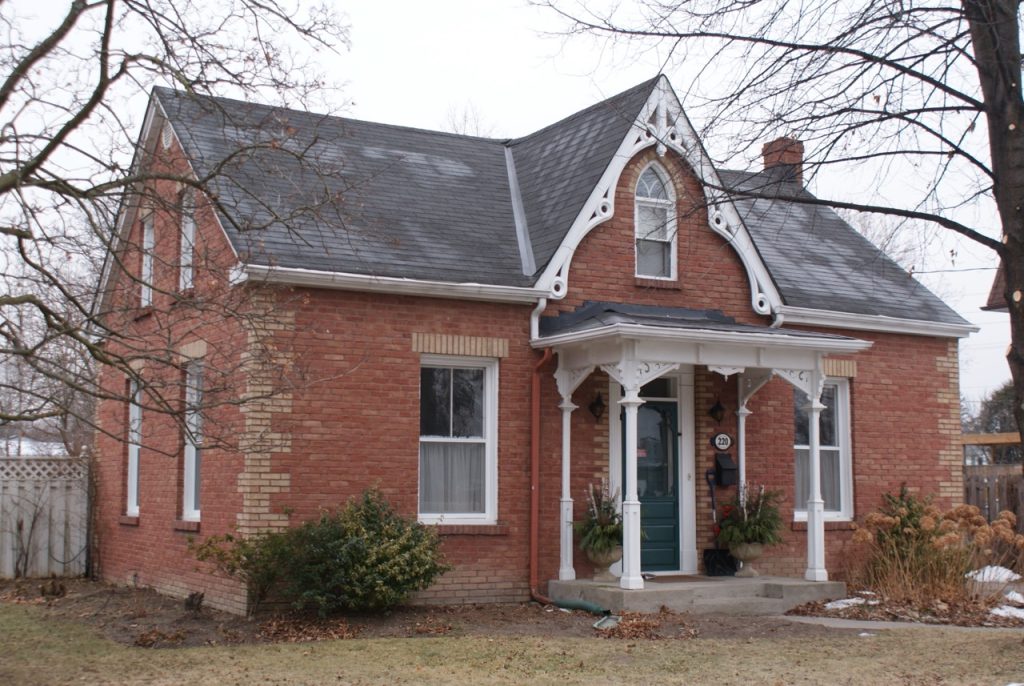
The instructions stated that this model could be built either of brick or of wood, depending on locally available materials and the budget of the soon-to-be homeowner. The design was made even more customizable with the option of a veranda, shutters, and a picket fence.
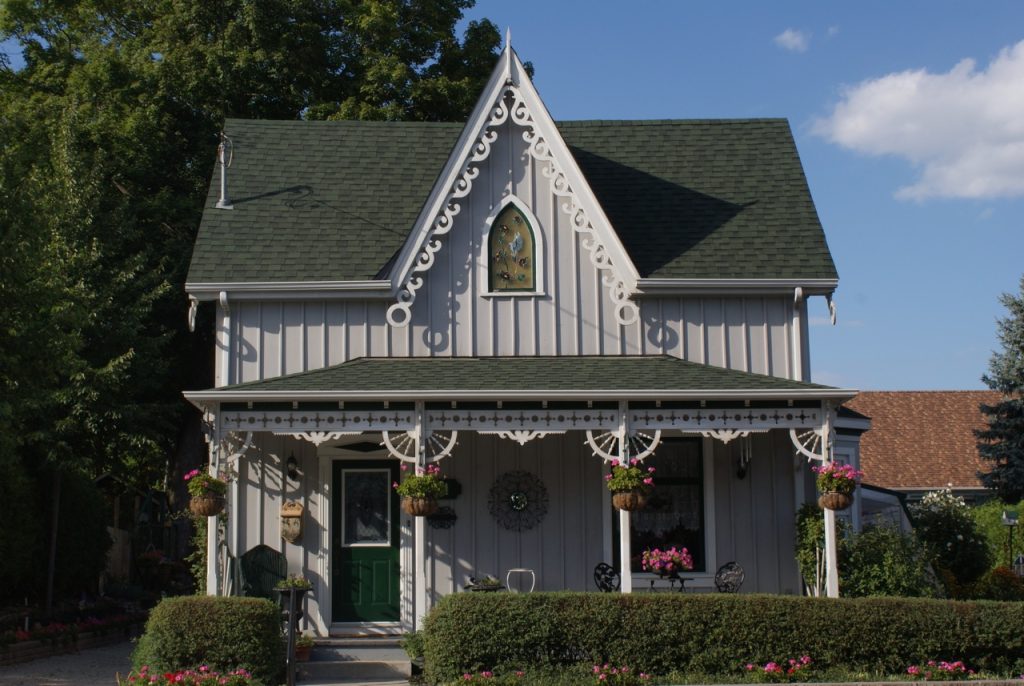
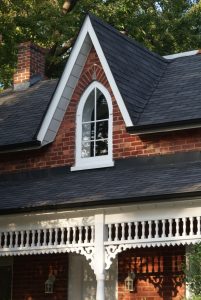
Beyond these modifications as outlined in the design brief, in practice, the pointed (or Gothic) window used in the central gable was often converted to a round-headed or squared window. Similar liberties were taken with the wooden bargeboard and finial, which could either be further embellished or omitted entirely. Overall, the cost of the model as presented in the pages of The Canada Farmer was estimated at $600 to $800 if made of wood.[4] This is roughly $10,500 to $14,000 CAD today.
Printed media and the built environment
Beginning in the late eighteenth century, the small house became a matter of direct architectural concern in industrializing nations, including in the British colonies that would later come to be known as Canada. With the rise of the Industrial Revolution social structures changed dramatically, calling for more variety in domestic architecture, and for smaller, affordable housing in particular. It also made building materials more affordable and easier to transport. Also at this time, print technology and distribution made it easier and more affordable for publications of all kinds to be printed and circulated. Both of these important social and economic factors changed the architectural industry in practice and in print.
British culture held considerable cultural and political sway in Canada throughout the 19th century. British architects had already turned their attention to the cottage providing detailed advice, plans, and cost breakdowns speaking directly to the growing middle class. Publications called pattern books were pioneered by Scottish landscape gardener John Claudius Loudon in 1832 with An Encyclopedia of Cottage, Farm, and Villa Architecture, and Furniture. The format became a popular and affordable way to spread architectural knowledge and taste. Similarly, around this time, architectural periodicals were established that gave advice for architects, builders, and tradespeople, but also for average people with an interest in architecture. Like pattern books, they also occasionally offered models for small homes. Examples include the influential British periodicals The Builder (est. 1843) and The Building News (est. 1854), which were circulated to the British colonies, including the territory now known as Ontario.
Why Gothic?
The prominent pointed window and the wooden bargeboard in The Canada Farmer design link this tiny home to the Gothic Revival trend. This was one of the most popular architectural movements of the nineteenth century, spreading like wildfire in the English-speaking world in particular. First emerging in England in the early eighteenth century, Gothic Revival architects looked to late medieval Gothic architecture for inspiration.
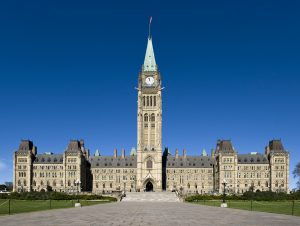
Gothic architecture’s popularity would inevitably impact Canadian popular taste, but also because most of the colony’s earliest architects were trained in England. Like in England, Gothic was used most notably in church architecture and in prominent secular buildings like the Parliament Buildings in Ottawa.
As time wore on, the Gothic style was used for smaller, less architecturally significant buildings too. This is because Gothic was believed in the nineteenth century to be the most adaptable of architectural styles. Understood then as a counterpoint to classical architecture, Gothic was seen to have fewer precise rules. For example, a classical Doric temple must follow exact plans, geometry, and measurements. Architects and patrons thought of classical design as harder to translate to different contexts without careful consideration. On the other hand, Gothic could be communicated with only a steep roof and a bit of simple ornamental detail (the pointed window, the bargeboard, or finial). And so, the Gothic Revival provided a path toward an affordable, stylish statement for small houses, and one that was well adapted, because of its steep roof, to shedding heavy snow fall. These are some of the reasons that these minimal Gothic designs caught on in Ontario.

A versatile model
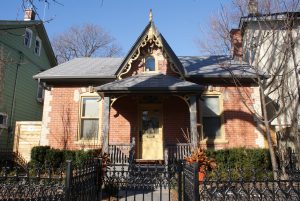
The Gothic design of “A Cheap Farm House” was not just popular in rural areas—we also find many examples of this model and related models in towns and cities across the province. This was particularly the case for those building in bulk or building speculatively to sell. There are many such homes even in Toronto, Ontario’s largest city.
“A Cheap Farm House” and The Canada Farmer acted as a connective thread in the architectural fabric of the province, speaking to a moment in time, and to a desire for style and comfort. This modest house fits into an important network of architectural ideas in Canada and beyond, demonstrating that the trajectory of architectural knowledge in the nineteenth-century was not always straightforward.
Next time you are out wandering, take a look at the old houses. There is much more behind their design than meets the eye.
About the author
Jessica Mace, Ph.D., is the current Postdoctoral Fellow in Canadian Architecture and Landscapes in the Department of Art History at the University of Toronto. Her research explores concepts of modernity and heritage in the architecture of the nineteenth through to the mid-twentieth centuries, particularly in housing and in industrial contexts in Canada. Since 2015, she has been the Editor in Chief of the Journal of the Society for the Study of Architecture in Canada and currently serves as Secretary on the Executive Committee of the Association of Critical Heritage Studies. She also serves as adjunct faculty in both the Department of Urban and Tourism Studies at the Université du Québec à Montréal and the Graduate Department of Visual Art and Art History at York University.
Further reading
“Canadian Farm Architecture.” The Canada Farmer 1, no. 1 (January 15, 1864).
Hill, Robert G. “James Avon Smith.” Biographical Dictionary of Architects in Canada, 2022.
Loudon, J. C. Encyclopaedia of Cottage, Farm, and Villa Architecture and Furniture. London: Longman, Brown, Green, and Longmans, 1842.
Mace, Jessica. “Beautifying the Countryside: Rural and Vernacular Gothic in Late-Nineteenth-Century Ontario.” Journal of the Society for the Study of Architecture in Canada 38, no. 1 (2013): 29–36.
Mace, Jessica. “The Evolution of the Toronto Bay-and-Gable House.” Ornamentum (Spring–Summer 2021): 29–33.
“Rural Architecture.” The Canada Farmer 1, no. 22 (November 15, 1864).
“To the Farmers of Canada!” The Canada Farmer 1 no.1 (January 15, 1864).
- “Rural Architecture,” The Canada Farmer 1, no. 22 (November 15, 1864): 340. ↵
- “To the Farmers of Canada!” The Canada Farmer 1 no.1 (January 15, 1864): 8. ↵
- “Canadian Farm Architecture,” The Canada Farmer 1, no. 1 (January 15, 1864): 7. ↵
- “Rural Architecture,” The Canada Farmer 1, no. 22 (November 15, 1864): 340. ↵
Settlers are people who migrate to a place that is foreign to them, with the intent of living there permanently, historically as part of colonization efforts. Development refers to the structures and infrastructure that these groups put into place such as architecture, farms, roads, etc. to mimic the ways of life with which they are familiar, with complete disregard for local populations and ways of living.
The Globe was one of the major newspapers in nineteenth-century Toronto. It gradually transformed into a national newspaper known today as The Globe and Mail.
A gable is the triangular section of a building that is formed by a pitched or sloped roof.
A bargeboard is the carved wooden ornament that lines the eaves of a house, most typically found in the gable. These can be used to hide roof timbers, but they can also be purely ornamental.
A finial is an ornament at the top or corner of a building.
Pattern books were a type of nineteenth-century architectural publication that featured designs (or patterns) for buildings. These books also typically featured advice, measurements, cost estimates, and even landscaping tips.
The Gothic Revival was a major movement in European architecture, lasting from the eighteenth century through to the early twentieth century. Beginning in England before spreading to the rest of Europe and worldwide, Gothic Revival enthusiasts looked back to medieval Gothic architecture for inspiration.

